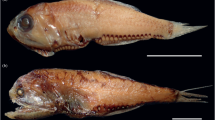Summary
This is the first find of aHypoblepharina species since Böhmig's description of this genus in 1914 based on three species from a depth of 385 m in Antarctic waters.H. böhmigi sp. n. lives as commensal in the brood pouch of an amphipod. It is easily recognized by its arched cuticular stylet provided with a triangular mouth-piece and has the same principal anatomical features as the species described by Böhmig. The chance that these species too may be commensal in amphipods, cannot be ignored as it was impossible to establish their true habitat on the basis of the available expedition material.
The family Hypoblepharinidae Böhmig is retained but its taxonomic diagnosis is revised.
Zusammenfassung
Hypoblepharina böhmigi sp. n. ist eine kommensalistische Art aus dem Marsupium der AmphipodeCheirimedon femoratus. Sie ist leicht erkennbar durch ihr bogenförmiges Kutikularsteilett mit triangulärem Mundstück. Drei Vertreter derselben Gattung wurden von Böhmig im Jahre 1914 aus 385 m Tiefe in antarktischen Gewässern beschreiben. Vielleicht sind auch diese Arten Kommensalem in Amphipoden. — Die Diagnose der GattungHypoblepharina wird revidiert.
Similar content being viewed by others
Literatur
Beauchamp, P. de: Un nouveau rhabdocoele marin,Prorhynchopsis minuta n.g., n.sp. Bull. Soc. Zool. France37, 299–302 (1913).
Beauchamp, P. de: Classe des Turbellariés, Turbellaria (Ehrenberg, 1832). In: Traité de zoologie, vol. IV, 1, P.-P. Grassé, ed., p. 35–212. Paris: Masson 1961.
Böhmig, L.: Die Rhabdocoelen Turbellarien und Tricladen der Deutschen Südpolar-Expedition 1901–1903. Deutsche Südpolar Exp.15, Zool.7, 1–34 (1914).
Bresslau, E.: Turbellaria. In: Handbuch der Zoologie, Vol. II, 1, W. Kükenthal u. T. Krumbach, ed., p. 52–304. Berlin-Leipzig: de Gruyter 1933.
Karling, Tor G.: Zur Morphologie und Systematik derAlloeocoela cumulata undRhabdocoela lecithophora (Turbellaries). Acta zool. fenn.26, 1–260 (1940).
Marcus, E.: Turbellaria Brasileiros 11. Papeis avulsos depart. zool. S. Paulo11, 419–489 (1954).
Meixner, J.: Beitrag zur Morphologie und zum System der Turbellaries-Rhabdocoela. II. ÜberTyphlorhynchus nanus Laidlaw und die parasitischen Rhabdocoelen nebst Nachträgen zu den Calyptorhynchia. Z. Morph. Ökol.5 577–624 (1926).
Meixner, J.: Turbellaria (Strudelwürmer). Tierw. Nord. OstseeIVb, 1–146 (1938).
Westblad, E.: Turbellaria (exel. Kalyptorhynchia) of the Swedish South Polar Expedition 1901–1903. Further Zool. Results Swed. Antaret. Exped. 1901–03 IV(8), 1–55 (1952).
Westblad, E.: Some Hydroida and Turbellaria from Western Norway, with description of three new species of Turbellaria. Univ. Bergen Årbok 1954. Naturv. rekke10, 1–22 (1954).
Westblad, E.:Marine “Alloeocoels” (Turbellaries) from North Atlantic and Mediterranean Coasts. I. Ark. Zool. (2)7, 491–526 (1955).
Author information
Authors and Affiliations
Rights and permissions
About this article
Cite this article
Karling, T.G. IstHypoblepharina Böhmig (Turbellaria) eine kommensalistische gattung?. Z. Morph. Tiere 75, 51–58 (1973). https://doi.org/10.1007/BF00723668
Received:
Issue Date:
DOI: https://doi.org/10.1007/BF00723668




